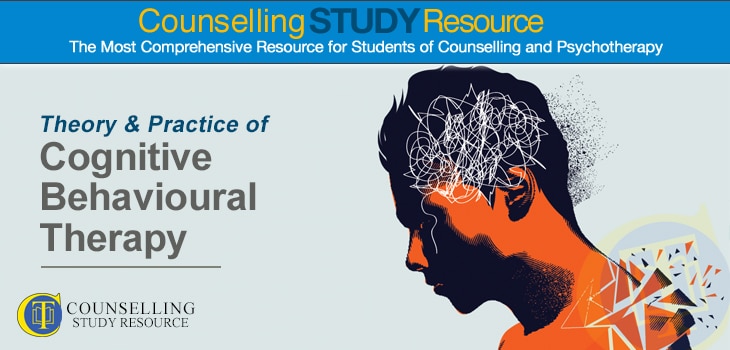What CBT Is
Cognitive behavioural therapy (CBT) is a type of psychotherapy based on a model that suggests that mental-health difficulties stem from dysfunctional thinking (which may arise from biological and/or psychological influences). CBT aims to change clients’ mood by identifying and modifying negative automatic thoughts and core beliefs, regulating routine and minimising avoidance. Because CBT encourages practice and compliance (often involving ‘homework’ tasks), it helps clients have a sense of control.
How and Where CBT Is Used
CBT tends to be used short-term (when the length of therapy is limited), and has been much researched using randomised controlled trials. It is widely used by the National Health Service in the UK, sometimes as an alternative to – and often in combination with – medication for anxiety (including obsessive-compulsive disorder and post-traumatic stress disorder) and/or depression (including bipolar disorder). It can also be useful for clients with eating disorders, relationship difficulties, chronic pain, insomnia or body dysmorphic disorder – and to support smoking cessation.
Theory of CBT
The idea is that modifying dysfunctional thinking and behaviour improves symptoms – and that modifying the dysfunctional beliefs that underlie dysfunctional thinking leads to longer-lasting change.
CBT practitioners believe that negative emotions are triggered by cognitive processes developed through the influences of learning and personality. Adverse life events elicit negative automatic thoughts (deriving from our understanding of ourselves, others and the future); these thoughts are believed to cause mental-health difficulties.
CBT examines the client’s cognitive beliefs, helps the client identify the cognitive errors they are most likely to make, and develops rational responses to negative automatic thoughts.
Negative Automatic Thoughts

These happen spontaneously in response to situations, and often occur in the form of words or images; they are irrational, follow no logical sequence, are hard to turn off, and may be difficult to articulate.
These thoughts often follow similar patterns, as clients tend to make consistent errors in their thinking, for example:
- emotional reasoning, in which the client believes feelings to be facts
- catastrophising, in which the client believes the worst is bound to happen
- all-or-nothing thinking , in which the client thinks that everything must be completely good or bad, with no ‘shades of grey’
- mind-reading, in which the client assumes they know what other people are thinking
- personalising, in which clients feel responsible for things outside their control.
Core Beliefs
Negative automatic thoughts are underpinned by core beliefs, which influence how clients process information and organise their understanding of their experiences. These core beliefs may not be evident until they are activated by stress or difficult life events. There are three key categories of core beliefs, with the client believing they are:
- helpless – e.g. incompetent, powerless, weak or inferior
- unloveable – e.g. unwanted, unattractive, boring or defective
- worthless – e.g. bad, toxic or undeserving of life.
Free Handout Download
How CBT Tackles Cognitive Errors
Negative Automatic Thoughts in Different Conditions
Different mental-health conditions are thought to trigger different types of negative automatic thoughts. For example, depression is based on a negative view of self, others and the future; core beliefs in a depressed person are associated with helplessness, failure, incompetence and unlovability. The depressed client may believe: ‘I am incompetent. People do not rate me. The future is bleak.’ The anxious client meanwhile overestimates both physical and psychological threats; core beliefs relate to risk, danger and uncontrollability. They might believe: ‘I can’t control when I cry. People will think I’m weak. It’s only a matter of time before I feel humiliated.’
In addition to anxiety and depression, CBT is also used to treat obsessive-compulsive disorder (examining obsessive/compulsive thoughts), anorexia (challenging the client’s thoughts on control, self-worth and perfection), panic (which involves catastrophising, and misinterpreting physical sensations) and paranoia (based on thoughts relating to trust and vulnerability).
How CBT Tackles Cognitive Errors
The therapist examines specific situations in which the client has found themselves, asking open questions such as:
- What was going through your mind at that time?
- What did the situation mean for you?
- How did your thinking affect you?
- What evidence is there for and against the underlying beliefs?
- Are there any other possible explanations?
- What would you tell a friend or relative who saw the situation like this?
- What could be the effect of changing your thinking?
- What could you do now?
Clients may complete a thought log with the therapist, using a table laid out as follows:
|
Situation |
Thoughts |
Emotions |
Rational response |
Outcome |
A common feature of CBT is that the therapist sets the client ‘homework’, which is then reviewed in the next session; this aims to help clients generalise and apply their learning.
